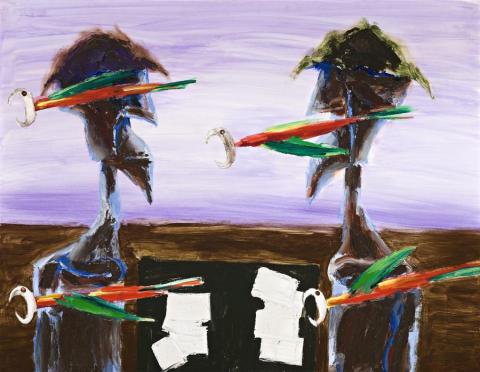GAMBLERS AND PARROTS, 1968
ALBERT TUCKER
synthetic polymer paint on composition board
106.5 x 136.5 cm
signed and dated lower right: Tucker 68
inscribed verso: “GAMBLERS AND PARROTS” / ALBERT TUCKER / 1968
Bonython Art Gallery, Sydney
Private collection, Melbourne
Private collection, Melbourne, acquired through Avant Galleries, Melbourne in 1973
Obra pictoria de Albert Tucker, Instituto Nacional de Bellas Artes, Mexico, February 1969, cat. 24 (as 'Jugador y papagayos')
Albert Tucker, Poindexter Gallery, New York, 15 March – 3 April 1969
Albert Tucker, Bonython Art Gallery, Sydney, 28 October – 19 November 1969, cat. 2
Gamblers and Parrots, 1960, synthetic polymer paint on composition board, 91.5 x 121.5 cm, private collection, illus.in Fry, G., Albert Tucker, Beagle Press, Sydney, 2005, p. 153
Through the craggy profiles of gaunt gamblers and the visual screech of parrots across the picture plane, Albert Tucker captures in Gamblers and Parrots, 1968, an aspect of the Australian character with extraordinary expressionist power. Blank white cards lie on the black tabletop as the gothic heads stare at each other in silence. They are shadowy characters of the grim faced background to the colourful plumage of the parrots, their wide-open beaks like wire cutters. Their pictorial ancestors are Tucker's explorers, who chanced their lives against the harsh environment. Set in an equally bleak landscape, these skeletal-like figures likewise fight for survival - on the luck of the turn of a card. There is also a touch of the autobiographical, for, as Tucker himself observed, 'The Artist is born on a tight rope and has to learn to live on it.'1 As in Sidney Nolan's black-helmeted Ned Kelly, Tucker, for his explorations of our national identity, developed his own Australian icon, the 'Antipodean Head'. Beginning with Images of Modern Evil, and realised in his explorers whose weathered heads took on the rugged appearance of the landscape, it reached its apotheosis in Antipodean Head, 1959, in the Art Gallery of New South Wales, Sydney, and related paintings. Alone or in pairs, the explorer had the parrot as his noisy companion. His map-like profile expressed a resilience, of toughness against harsh odds, first the country and its climate, and then the luck of life - the chance, the gamble. It is part of the Australian character - born of the gold rushes of the 1850s, a bet on the horses, the lottery that brought home millions, and cards - poker faced players of the game of the same name. As Gavin Fry observed, 'The image of the gambler, singly or in pairs, became a regular image in Tucker's suite of subjects.'2 An earlier version, Card Players, 1957, is in the collection of the Queen Victoria Museum and Art Gallery, Launceston, and Gamblers (Card Players), 1962 is in Darwin in the collection of the Museum and Art Gallery of the Northern Territory.3 For the more closely related Gamblers and Parrots, 1960 (private collection), parrots befriend the players and the cards are turned up - all of the black ace of spades excepting a single heart. The subject of card players has, of course, fascinated many a major artist. In the 1890s, for example, Paul Cézanne produced a series of five paintings on the subject, brilliant examples being in the Musée d'Orsay, Paris, and the Metropolitan Museum of Art, New York.
1. Albert Tucker to John Reed, 23 April 1950. Reed Papers. Quoted in Richard Haese, 'Australian Gothic: The Art of Albert Tucker 1945-1960', Albert Tucker Paintings 1945-1960, Tolarno Galleries, Melbourne, 1982, unpaginated
2. Fry, G., Albert Tucker, Beagle Press, Sydney, 2005, p. 154
3. See Fry, op. cit, pp. 131 and 157
DAVID THOMAS
